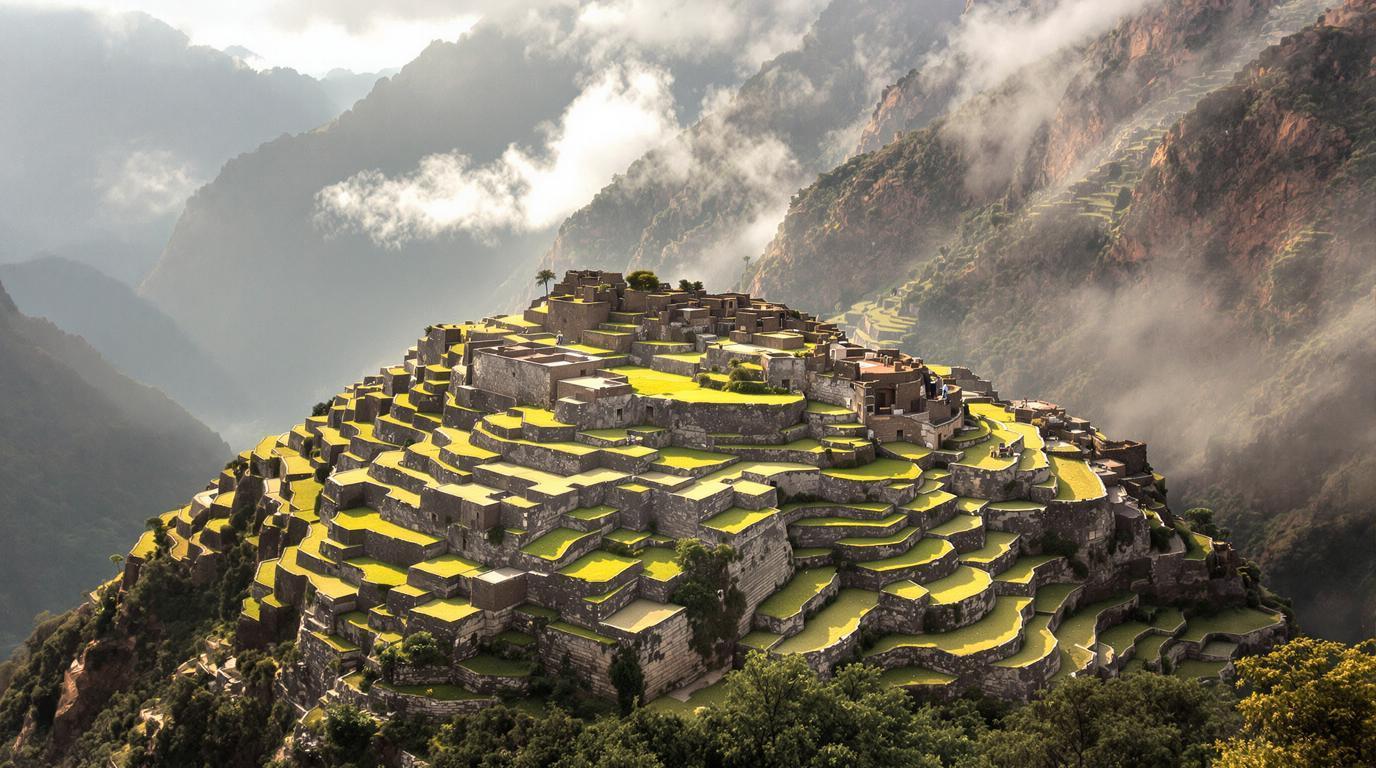Standing at 7,972 feet above Peru’s cloud forest, I watched the sun pierce through morning mist to reveal stone terraces that have remained virtually untouched for 500 years. While 6,000 daily visitors crowd Machu Picchu’s ancient pathways, this sister citadel welcomes fewer than 20 souls each day to its sacred plazas and ceremonial platforms.
Choquequirao, meaning “Cradle of Gold” in Quechua, sprawls across mountainous terrain twice the size of its famous neighbor. Unlike Machu Picchu’s train-accessible convenience, this archaeological marvel demands a commitment that filters out casual tourists and rewards only the most determined explorers.
The numbers tell the story of authentic discovery versus mass tourism. Machu Picchu’s 5,600 daily permits sell out months in advance, generating crowds that snake through narrow stone passages like rush-hour traffic. Choquequirao receives 5,000-8,000 visitors annually—roughly the same number Machu Picchu sees in a single day during peak season.
The lost citadel that rivals Machu Picchu’s grandeur
Architectural secrets hidden in the clouds
Choquequirao’s stone masonry displays the same precision that made Machu Picchu famous, yet its structures tell a different story. The Ushno ceremonial platform aligns with astronomical events, while the Hauqaypata plaza stretches wider than any space found in Machu Picchu. These aren’t tourist replicas—they’re original Inca engineering marvels that archaeologists believe served as a crucial administrative center connecting Cusco with the Amazon basin.
The scale that dwarfs Peru’s most famous ruins
Covering 2,000 hectares compared to Machu Picchu’s 80 hectares, Choquequirao reveals agricultural terraces that cascade down mountain slopes like frozen waterfalls. The Urin ceremonial square, positioned at the site’s highest point, commands views across the Apurímac River valley that no photograph can capture. Standing here, you understand why Inca engineers chose this location—it’s a natural fortress that controlled trade routes between the highlands and jungle.
The authentic experience that mass tourism destroyed elsewhere
Silence that allows ancient stones to speak
The absence of crowds creates something impossible at Machu Picchu: genuine solitude among ancient ruins. Without tour groups rushing between photo stops, you can actually hear the wind through stone doorways and feel the weight of history in empty plazas. This silence isn’t accidental—it’s the natural result of Choquequirao’s remote location and demanding access requirements.
Archaeological discoveries still happening today
While Machu Picchu’s stones have been photographed millions of times, Choquequirao continues revealing secrets. Recent excavations uncovered llama-shaped terraces visible only from specific vantage points, suggesting the entire site was designed as a massive geoglyph. These discoveries happen because fewer visitors means less disturbance to ongoing archaeological work.
The exclusive trek that separates explorers from tourists
The journey that creates the reward
Reaching Choquequirao requires a minimum 4-day trek covering 60-70 kilometers through changing ecosystems. The trail descends into the Apurímac River valley before climbing again through cloud forest, creating an elevation gain and loss that tests even experienced hikers. This physical challenge isn’t a barrier—it’s the filter that ensures only serious adventurers reach the ruins.
Camping under stars that city lights never dim
Night accommodation means tents pitched on mountainsides where Milky Way visibility reaches levels impossible near populated areas. The absence of light pollution creates the same star-filled skies that guided Inca astronomers, connecting modern visitors to ancient scientific traditions. This high-altitude sanctuary experience mirrors other exclusive mountain destinations where elevation and isolation create authentic encounters with nature.
Insider access and local secrets
The guides who know stories tour books don’t tell
Local guides from nearby Cachora village carry knowledge passed down through generations of families who never left the region. They point out plant species the Inca cultivated, explain water channel systems still functioning after 500 years, and share legends about specific stones that connect to broader Andean spiritual beliefs. This isn’t rehearsed tourist information—it’s living cultural knowledge.
Weather windows that smart travelers exploit
July’s dry season creates perfect trekking conditions with daytime temperatures reaching 75°F and clear mountain views extending for miles. Most visitors attempt the trek during shoulder seasons, leaving July’s optimal weather surprisingly uncrowded. Smart travelers choosing less obvious timing discover that peak conditions don’t always mean peak crowds.
Choquequirao represents what Machu Picchu was before tourism transformed it into a managed experience. While cable car proposals threaten to change this dynamic, current access requirements ensure that reaching these ruins remains an achievement rather than a purchase. For travelers seeking authentic connection with Inca civilization, the question isn’t whether Choquequirao is worth the effort—it’s whether you’re willing to earn what most travelers miss because they choose convenience over authenticity.
Frequently Asked Questions
How difficult is the Choquequirao trek compared to other Inca sites?
The trek requires excellent physical condition with steep descents into the Apurímac valley followed by challenging climbs reaching 3,050 meters elevation. Most trekkers need 4-5 days compared to Machu Picchu’s train access or the Inca Trail’s more gradual ascent.
Can I visit Choquequirao without a guide?
While technically possible, the remote location and unmarked trails make guided tours essential for safety and cultural interpretation. Local guides from Cachora village provide crucial navigation and historical context that transforms the experience from hiking to cultural immersion.
What’s the best time to trek to Choquequirao?
The dry season from May through September offers the most stable weather, with July providing optimal conditions of clear skies and comfortable temperatures. Avoid rainy season (November-April) when trails become muddy and river crossings dangerous.
How much does a Choquequirao trek cost?
Expect to pay $600-1,200 per person for a 4-day guided trek including permits, meals, camping equipment, and transportation to the trailhead. This compares favorably to Machu Picchu’s $650-1,300 total cost when including train tickets, permits, and accommodation.
Why do so few people visit Choquequirao?
The challenging 4-day minimum trek eliminates casual tourists, while Machu Picchu’s accessibility attracts visitors seeking Instagram photos rather than authentic archaeological experiences. This natural filter preserves Choquequirao’s authentic atmosphere and ongoing archaeological discoveries.
